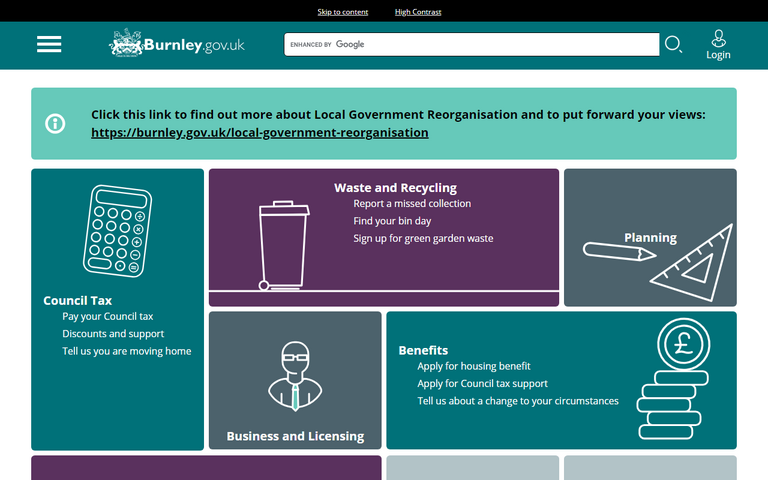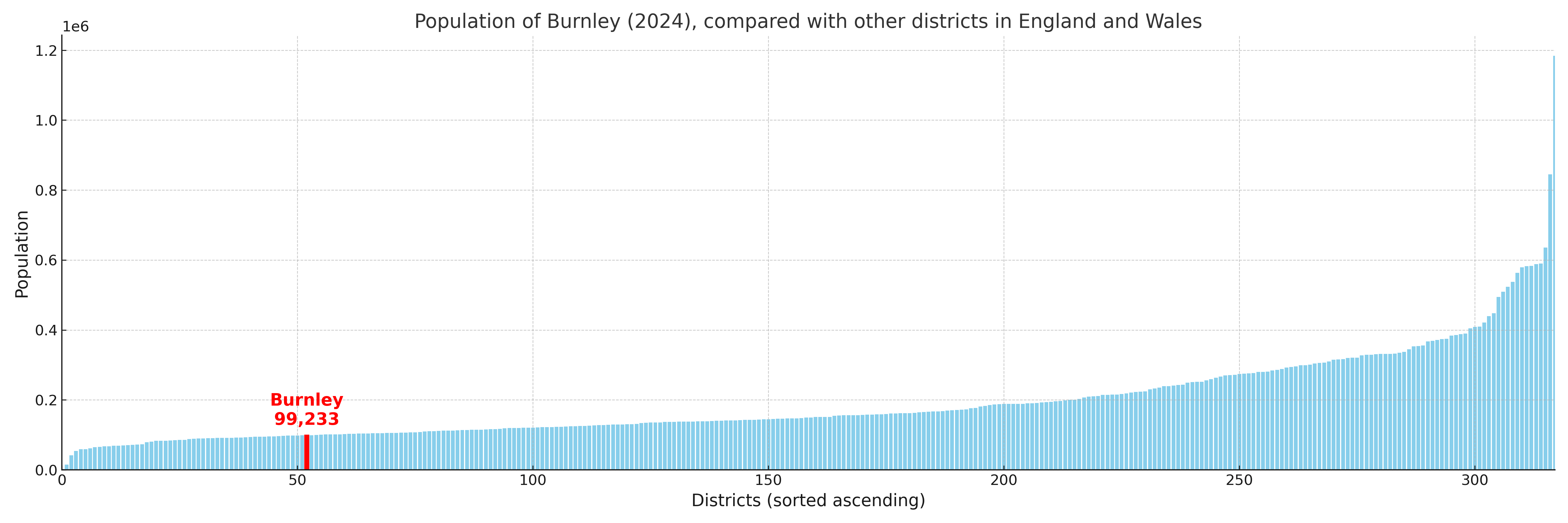Burnley
§ This page gives an overview of the Burnley local authority district, bringing together key facts, maps, and data to help you quickly understand the area. One of 361 district profiles on Baseview.
Overview ⁞ Burnley sits at the foot of the Pennines in Lancashire, where the River Calder and River Brun meet. The town is noted for its historic weavers’ cottages, Towneley Hall and Park, and the iconic Singing Ringing Tree sculpture overlooking the moors. The Leeds and Liverpool Canal runs through, with aqueducts and mills reflecting its industrial past. Surrounding hills and moorland provide dramatic scenery, with walking routes leading into the South Pennines. Burnley’s blend of heritage and rugged countryside gives it a distinctive character.
Burnley Boundary Map
This map shows the official boundary of the Burnley local authority district, based on the latest geographic data published by the Office for National Statistics (ONS). It provides a clear view of the district’s extent and helps you understand how the area fits within the wider regional and national landscape.
Contains OS data © Crown copyright and database right 2025. Source: Office for National Statistics licensed under the Open Government Licence v3.0.
The administrative boundary of Burnley can also be viewed on OpenStreetMap: District Boundary of Burnley.
Key Facts about Burnley
What region is Burnley in? Burnley is in the North West of England, a region within the UK.
What county is Burnley in? Burnley is located in the county of Lancashire.
Is Burnley a city? No, Burnley is not a city. (Note: the UK has 76 officially designated cities.)
Who governs Burnley? The local authority for this district is: Burnley Borough Council - responsible for district-level services. Since Lancashire is a two-tier area, county-level services are handled by: Lancashire County Council.
▶ Official website of Burnley Borough Council 🔗 burnley.gov.uk

Which police force covers Burnley? Policing in Burnley is provided by Lancashire Constabulary 🔗 lancashire.police.uk, which serves 14 local authority districts: Blackburn with Darwen ⁞ Blackpool ⁞ Burnley ⁞ Chorley ⁞ Fylde ⁞ Hyndburn ⁞ Lancaster ⁞ Pendle ⁞ Preston ⁞ Ribble Valley ⁞ Rossendale ⁞ South Ribble ⁞ West Lancashire ⁞ Wyre.
Constituencies in Burnley
Burnley is divided into 1 parliamentary constituencies, listed below in alphabetical order.
A constituency is a specific geographical area that elects one Member of Parliament (MP) to represent them in the House of Commons. The United Kingdom is divided into 650 parliamentary constituencies. We have this list page for easy browsing of all UK parliamentary constituencies: List of Constituencies.
Wards in Burnley
Burnley is divided into 15 wards, listed below in alphabetical order.
- Bank Hall
- Briercliffe
- Brunshaw
- Cliviger with Worsthorne
- Coal Clough with Deerplay
- Daneshouse with Stoneyholme
- Gannow
- Gawthorpe
- Hapton with Park
- Lanehead
- Queensgate
- Rosegrove with Lowerhouse
- Rosehill with Burnley Wood
- Trinity
- Whittlefield with Ightenhill
In the UK, a ward is a subdivision of a local authority area, used mainly for electoral and statistical purposes. Defined by the ONS, wards represent the primary unit for local elections, each returning one or more councillors to the local council. Wards are also used as a key geography for presenting population and census data.
Parishes in Burnley
Burnley is part-parished: 8 civil parishes (listed A-Z below) alongside 1 unparished areas.
- Briercliffe
- Cliviger
- Dunnockshaw
- Habergham Eaves
- Hapton
- Ightenhill
- Padiham
- Worsthorne-with-Hurstwood
A civil parish is the lowest tier of local government in England, used for villages, small towns, and suburbs. They have their own local authority, either a parish council or a parish meeting, which provides local services like managing parks, allotments, and streetlights, and represents the community's views to larger councils.
Built-up Areas in Burnley
Burnley covers 11 built-up areas, listed below in alphabetical order.
- Altham *
- Brierfield *
- Burnley *
- Cliviger
- Hapton
- Higham (Pendle) *
- Padiham *
- Rawtenstall *
- Simonstone *
- Todmorden *
- Worsthorne
In the UK, a Built-up Area (BUA) is a continuous urban area of at least 20 hectares (0.2 km²), defined by the ONS as land where buildings are generally no more than 200 metres apart, such as towns, cities, or large villages. (Note: A BUA name marked with an asterisk (*) indicates that the area is situated partly in the district of Burnley.)
Burnley compared with other districts in the UK
This section shows how Burnley compares with other local authority districts in the UK, using a variety of measures and rankings.
Burnley has 15 electoral wards.

Burnley has a population of 99,233 (2024 mid-year estimate by ONS)

More local statistics and data for Burnley can be found on the ONS statistics for Burnley.